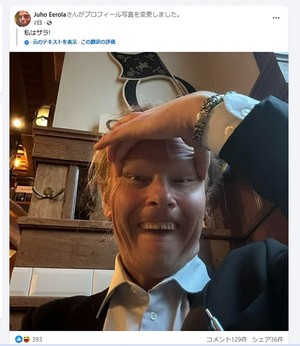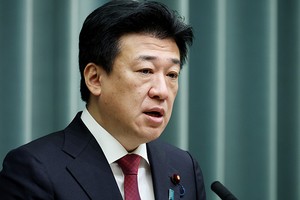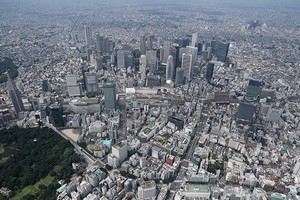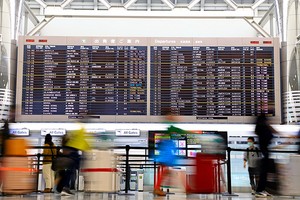THE ASSOCIATED PRESS
September 14, 2022 at 11:45 JST
 The logo on a sign outside a Starbucks coffee shop, March 14, 2022, in Londonderry, N.H. (AP Photo)
The logo on a sign outside a Starbucks coffee shop, March 14, 2022, in Londonderry, N.H. (AP Photo)
Starbucks--ringing up record sales but struggling with low employee morale--plans to spend $450 million next year to make its North American stores more efficient and less complex.
The company also said it plans to open 2,000 net new stores in the U.S. by 2025, with an emphasis on meeting the growing demand for new types of service, including drive-thru, mobile ordering and delivery. Drive-thru now makes up 50 percent of U.S. sales, for example, while delivery demand has grown by 24 percent so far this year.
“It’s clear that our physical stores have to change. Our physical stores were built for a different era,” said John Culver, Starbucks’ chief operating officer, at a day-long event for investors in Seattle Tuesday.
Culver said customizable cold drinks--which now make up as many as 75 percent of Starbucks’ U.S. beverage orders--are taxing employees in kitchens designed for simpler hot drinks. Starbucks debuted a new workstation that requires less movement and can cut 50 seconds off the process of making a blended iced mocha. It also announced a new patented technology that will cut the time needed to make cold brew coffee from 20 hours to a few seconds.
The introduction of an increasing number of hot food items is also slowing Starbucks’ kitchens. Culver said Starbucks expects to serve 300 million breakfast sandwiches in the U.S. this year, each of which takes up to 85 seconds to warm in its ovens. Starbucks plans to start cooking them in batches and storing them in warmers next to the drive-thru windows.
The company touted other upcoming benefits for workers, including more flexible scheduling, more generous sick time accrual and expanded ability for mobile customers to tip.
Starbucks executives made little mention of a growing unionization effort at its U.S. stores during morning presentations Tuesday. But it has clearly been an impetus for the company to think more deeply about ways to improve employees’ work life. Since late last year, 236 of Starbucks’ 9,000 company-owned U.S. stores have voted to unionize, an effort the company opposes.
“The reality is, we have a trust deficit with our partners,” said Frank Britt, Starbucks’ executive vice president and chief strategy officer. “The work we do in our stores today is too physically hard.”
It wasn’t immediately clear if the new investments and technology would be offered to non-union stores; Starbucks said the company hasn’t yet decided how the investment will be doled out. But in May, Starbucks announced $200 million in additional pay and training but said that benefit would only go to non-union stores.
Starbucks says it is required to negotiate new benefits with union stores. But in August, the Seattle office of the National Labor Relations Board filed a complaint against the company, saying it was violating U.S. labor law by withholding wage increases and other benefits from workers in unionized stores. A hearing in that case before an NLRB administrative judge is scheduled for October.
Starbucks Workers United, the union organizing workers, said around 300 protesters picketed outside the Starbucks meeting on Tuesday.
Culver said the company will respect the unionization process and negotiate with the stores that vote to unionize. But he also reiterated the company’s position.
“There are two paths. We can work together as partners, side by side, or we can have a third party between us,” he said.
Leading the company’s revamp will be Laxman Narasimhan, a former PepsiCo executive who was named Starbucks’ CEO last week. Narasimhan will spend the next six months shadowing interim CEO Howard Schultz, who helped shape the company after buying it in 1987 and has been leading it on a temporary basis since April. Schultz will remain on Starbucks’ board when Narasimhan assumes the CEO position in April.
“It’s an incredible opportunity for me to be learning at the feet of one of the best entrepreneurs in the world,” said Narasimhan, who described himself as a “right-brained” operational expert who also loves art, music and writing poetry.
Narasimhan, 55, who most recently was CEO of the U.K.-based consumer health and hygiene company Reckitt, also said he agrees that Starbucks has to renew its focus on exceeding its employees expectations if it wants to serve its customers well.
Schultz said Starbucks notched the best sales week in its 51-year history in August when it introduced its fall drink lineup. But Schultz said Starbucks lost its way during the pandemic, when employee retention tumbled even as customers demanded new service like curbside pickup.
Starbucks shares fell 1.4 percent Tuesday during a broader market downturn as investors fretted about stubbornly high inflation.




















A peek through the music industry’s curtain at the producers who harnessed social media to help their idols go global.
A series based on diplomatic documents declassified by Japan’s Foreign Ministry
Here is a collection of first-hand accounts by “hibakusha” atomic bomb survivors.
Cooking experts, chefs and others involved in the field of food introduce their special recipes intertwined with their paths in life.
A series about Japanese-Americans and their memories of World War II